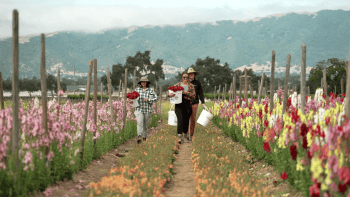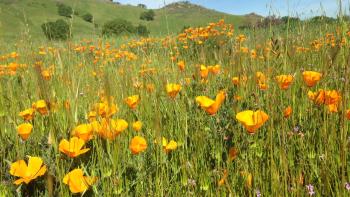Spicing Up Santa Clara Valley Life
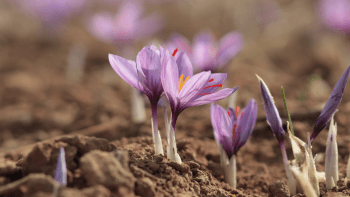
As a fourth-generation farmer from a renowned saffron-producing family in Kashmir, India, Wasim Sahibzada carries a legacy of passion and expertise in saffron cultivation. This deep-rooted connection inspired him to continue his family's proud tradition when he immigrated to California, aiming to introduce this prized spice to his new community. As a public agency that protects working lands and supports local farmers, the Santa Clara Valley Open Space Authority was eager to help Wasim embark on his saffron farming journey by leasing him a one-acre plot of land. With this opportunity, Wasim seeks to bring the rich heritage of saffron cultivation to the Santa Clara Valley and share its unique value with the region.

Saffron is a spice, also known as Crocus sativus, with a beautiful purple-hued flower that grows out of a round, bulbous seed called a “corm.” Typically, a corm sprouts one to three flowers at a time and, once a flower is plucked, the corm is then able to reproduce one to two additional times before it goes dormant for the winter. After a corm produces for five years, it must be extracted from the ground, split and replanted to maintain its ability to produce in the future.
Inside each flower are three red stamen or “threads” which are carefully detached from the rest of the flower once it’s been picked and used as a fragrance, dye and spice. Typically, it’s sold in grocery stores and used in other commercial enterprises like the production of perfumes, alternative medicine like ayurveda, cosmetics, food and tobacco. On average, it takes around 75,000 saffron flowers to produce one pound of saffron threads, a fact that demonstrates just how labor intensive harvesting the flowers can be as well as the reason for its high value.

Saffron originates from Persia and was brought to the Kashmir region of India around 500 B.C. Today, Kashmir is the only producing region of saffron in India and the second largest producer of saffron in the world, which makes it a sought-after destination for those who want to gain a better understanding of this delicate and unique spice. “Saffron has a huge cultural significance in India,” Wasim said. “The cuisine in Kashmir revolves around saffron and it’s thought to have healing powers.” Wasim described the flavor of saffron as sweet, yet bitter and recommends preparing a delicious, saffron-infused tea known as “Kahwa” by steeping a few threads in water with a dash of cinnamon.
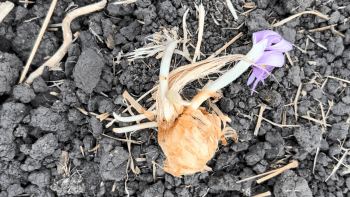
In 2024, Wasim started to grow saffron on his own with just a few flowers planted in small pots at his home in California. Wasim immigrated to the United States from India in 2015 to obtain both undergraduate and master’s degrees in construction management yet felt a pull to continue his family’s tradition of growing saffron. “California has the ideal temperatures, conditions and soil that is apt for saffron cultivation,” Wasim shared. “All you need is a little water or rain for saffron to be successful.”
As Wasim gained more experience growing saffron at home, he started to experiment with different growing techniques including using compost as a soil base. Once he saw how well the flowers and corms reacted to the compost, Wasim set out to develop connections within the agricultural community to see if he could grow saffron on a local plot of land. Eventually, he met Julie Morris, Santa Clara County’s Agricultural Liaison who connected Wasim to the Santa Clara Valley Open Space Authority.
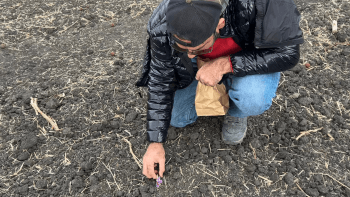
“Wasim is a perfect example of how Santa Clara County continues to be a land of opportunity, not only for tech entrepreneurs, but for innovative and young farmers. I was thrilled to introduce him to Aaron Hébert at the Open Space Authority who was more than willing to discuss a lease on some of their farming ground. The Authority’s support of young farmers like Wasim is a testament to their commitment to protect the most important remaining farmlands in the Coyote Valley, while creating economic opportunities for our agricultural community."
Wasim’s pilot project launched in September 2024 and already saw success with saffron flowers blooming just a few months later in November. Due to this success, he now hopes to increase production during the 2025 saffron harvest and cultivation season and provide Santa Clara Valley residents with hands-on learning opportunities. “I want California to be known as a producer of saffron,” Wasim said. “I want to teach community members about saffron, let them pick their own threads and know what saffron is all about.” While the corms remain dormant over the next few months, Wasim is using this time to plan his next phase for saffron cultivation and is hopeful that this is just the beginning of his journey growing California saffron.

“The Open Space Authority is excited to support innovative farming projects like Wasim's. We hope to see his operations grow next season and beyond, and as we continue to build out support systems for our Coyote Valley farmers, we hope others will do the same."
Santa Clara Valley residents can support local farmers like Wasim in a variety of ways including purchasing produce and other food products from farmers markets or signing up for Community Supported Agriculture (CSA) boxes that connect community members to local farms through the delivery of fresh, seasonal produce. It’s also encouraged to follow local farms on social media to be the first to know about their events and initiatives that involve the public.
Follow Wasim’s saffron farming journey on Instagram @safcosaffron.
